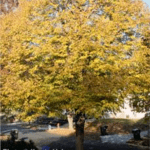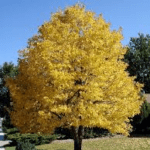Little Leaf Linden
Easily grown in average, medium, well-drained soils in full sun to part shade. Prefers moist, fertile, well-drained loams, but adapts to a wide range of soil conditions. Good tolerance for urban conditions. Tolerant of heavy pruning, and may be grown as a hedge. Native to Europe, littleleaf linden has been widely planted in the U. S. as an ornamental shade tree because of its attractive foliage, dense low-branches, and tolerance for urban conditions.
American Linden
This tree is noted for its cymes of fragrant, pale yellow, late spring flowers, small nutlets which follow the flowers and ripen by late summer, mucilaginous sap, noticeable winter buds, and large ovate dark green leaves (to 6” long) with acuminate tips, serrate margins, often silvery undersides and uneven cordate bases. Fall color is an undistinguished pale green to pale yellow. Winter twigs and buds are sometimes tinged with red. When a tree is in full bloom, bees often visit in such abundant numbers that humming can be heard many feet from the tree. Honey made from the nectar of these flowers is a prized gourmet item. Flowers have also been used to make tea. Syrup can be made from the sweet tree sap.


